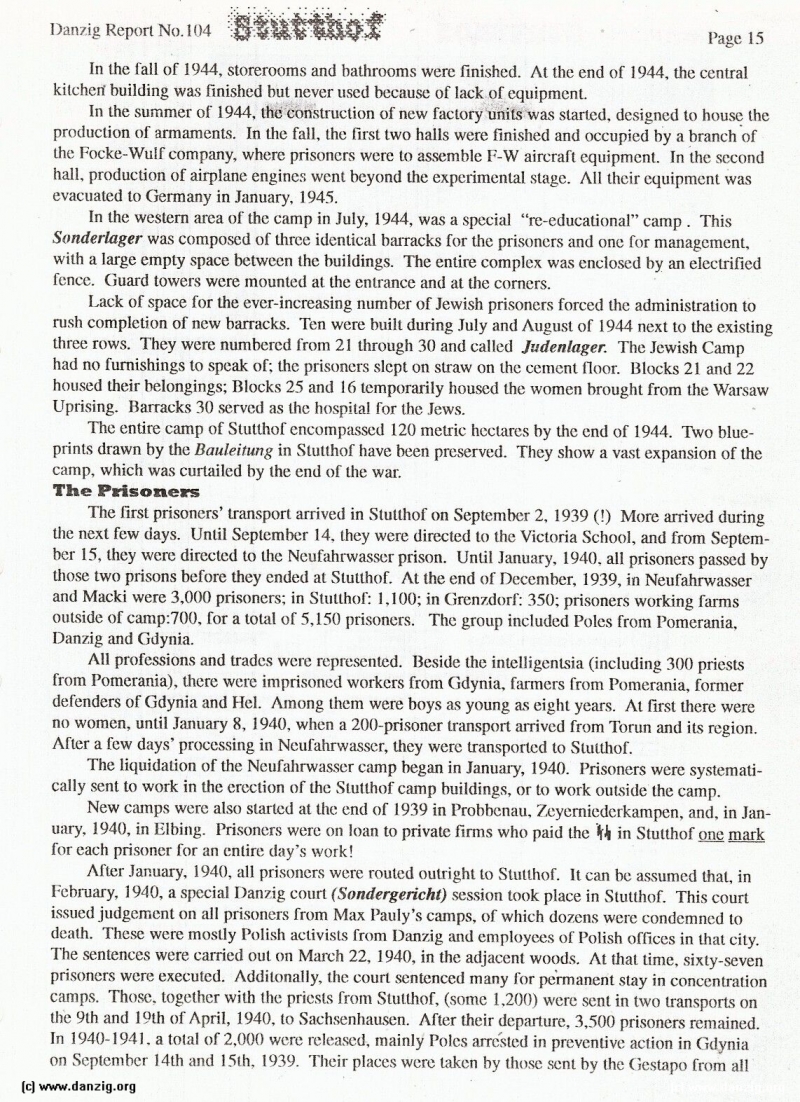
in the fall of 1944, storerooms and bathrooms were finished. At the end of 1944. the central kitchen building was finished hut never used because of lack of equipment.
In the summer of 1944, the construction of new factory units was started, designed to house the production of armaments. In the fall, the first two halls were finished and occupied by a branch of the Focke-Wuif company, where prisoners were to assemble F-W aircraft equipment. in the second hail, production of airplane engines went beyond the experimental stage. All their equipment was evacuated to Germany in January, 1945.
In the western area of the camp in July, 1944, was a special “re-educational” camp. This Sonderlager was composed of three identical barracks for the prisoners and one for management. with a large empty space between the buildings. The entire complex was enclosed by an electrified fence. Guard towers were mounted at the entrance and at the corners.
Lack of space for the ever-increasing number of Jewish prisoners forced the administration to rush completion of new barracks. Ten were built during July and August of 1944 next to the existing three rows. They were numbered from 21 through 30 and called Judenlager. The Jewish Camp had flO furnishings to speak of: the prisoners slept on straw on the cement floor. l3locks 21 and 22 housed their belongings; Blocks 25 and 16 temporarily housed the women brought from the Warsaw Uprising. Barracks 30 served as the hospital for the Jews.
The entire camp of Stutthof encompassed 120 metric hectares by the end of 1944. Two bluep rints drawn by the Bauleitung in Stutthof have been preserved. They show a vast expansion of the camp, which was curtailed by the end of the war.
The Prisoners
The first prisoners’ transport arrived in Stutihof on September 2, 1939 (!) More arrived during the next few days. Until September 14. they were directed to the Victoria School, and from Septemb er 15, they were directed to the Neufahrwasser prison. Until January. 1940, all prisoners passed by those two prisons before they ended at Stutthof. At the end of December. 1939, in Neufahrwasser and Macki were 3,000 prisoners: in Stuithof: I .100: in Grcnzdorf: 350: prisoners working farms outside of camp:700, for a total of 5.150 prisoners. The group included Poles from Pomerania. Danzig and Gilynia.
All professions and trades were represented. Beside the intelligentsia (including 300 priests from Pomerania), there were imprisoned workers from (Idynia, farmers from Pomerania, former defenders of Gdynia and Hel. Among them were boys as young as eight years. At first there were no women, until January 8. 1940, when a 200-prisoner transport arrived from Torun and its region. After a few days’ processing in Ncufahrwasscr, they were transported to Stutthof.
The liquidation of the Neufahrwasser camp began in January, 1940. Prisoners were systematic ally sent to work in the erection of the Stutthof camp buildings, or to work outside the camp. New camps were also started at (lie end of 1939 in Prohhenau. Zcyerniederkampen, and, in Janu ary. 1940, in Elbing. Prisoners were on loan to private firms who paid the Ird in Stutthof mark for each prisoner for an entire (lay’s work!
After January, 1940, all prisoners were routed outright to Stutthof. It can be assumed that, in February, 1940, a special 1)an7ig court (Sondergericht) session took place in Stutihof. This court issued judgement on all prisoners from Max Pauly’s camps. of which dozens were condemned to death. These were mostly Polish activists from l)anzig and employees of Polish offices in that city. The sentences were carried out on March 22, 1940, in the adjacent woods. At that time, sixty-seven prisoners were executed. Additonally, the court sentenced many for pcrmanent stay in concentration camps. Those, together with the priests from Stutthof, (some 1,200) were sent in two transports on the 9th and 19th of April, 1940, to Sachsenhausen. After their departure, 3,500 prisoners remained. In 1940- 1941. a total of 2.00() were released, mainly Poles arreted in preventive action in Gdynia on September 14th and 15th. 1939. ‘I’heir places were taken by those sent by the Gestapo from all
Danzig Report Vol. 1 - Nr. 104 - July - August - September - 1999, Page 15.
Hits: 1861
Added: 25/07/2015
Copyright: 2024 Danzig.org

